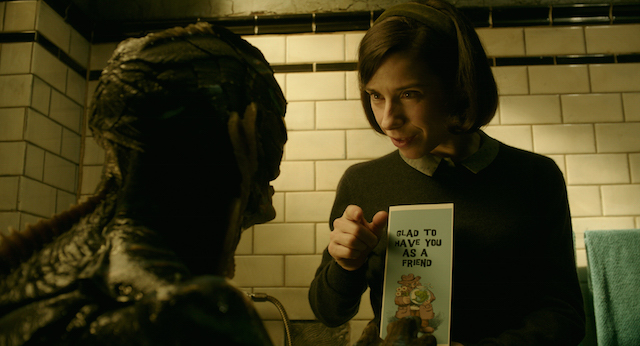
[THE FOLLOWING REVIEW CONTAINS MILD SPOILERS]
The Shape of Water is whimsical, boldly original, defiantly weird, occasionally grotesque, and beautifully shot in shades of green I didn’t even know existed. It is directed (and co-written) by the great Mexican filmmaker Guillermo del Toro, clearly in full command of his gifts. And yet, despite all of that, the film didn’t quite work for me. Let’s explore.
It’s the early 1960s in Baltimore (although the city is mostly used generically, except for an instantly familiar font on a city bench). Our heroine is the mousy, mute (but not deaf) Elisa (a preternaturally expressive Sally Hawkins) who works as a janitor at a government laboratory alongside her loyal friend Zelda (Octavia Spencer, great as usual). Elisa’s other best friend is her neighbor Giles (Richard Jenkins), an artist who does photo-realistic illustrations for advertising agencies. Giles is also gay and closeted and deeply sad about his misspent youth, his receding hairline, and incipient old age. He and Elisa have a relationship akin to a sexless marriage—she brings him breakfast every morning and they watch TV together and share the mundane details of each other’s lives. But neither Elisa nor Giles are sexless—quite the contrary. Giles goes to a local pie shop where he flirts, tentatively, with the coffee jerk. Elisa masturbates furiously in her claw-footed bathtub every morning.
One day, the uniformed bureaucrats at the laboratory bring in a sea creature—scaly, green, alien-eyed, humanoid (but definitely not human). The man in charge of securing and studying the amphibian is the sadistic Richard Strickland (Michael Shannon), who has also taken an uncomfortably keen interest in Elisa. The kindly Dr. Robert Hoffstetler (Michael Stuhlbarg, having himself a year), a man with many secrets of his own, is in charge of caring for the creature.
Elisa is fascinated by the sea creature right away—tapping on its glass tank to get its attention, feeding it hard-boiled eggs, and playing jazz records for it. She teaches it sign language. Eventually, she and the sea-man become friends—and then something more.
The film pivots on the fact that Strickland intends to kill the sea creature and study it for scientific and military purposes—but mostly to ensure that the Ruskies don’t get it first. Elisa, aided by Zelda and a reluctant Giles, stages a breakout.
She eventually brings the creature home—it resides in her bathtub —and, well, there’s no other way to put it: She and the creature get it on. I know, right?
I’ve heard some people on Twitter suggest that there’s nothing unusually kinky about this—after all, the mermaid has been a male sexual fantasy for years. But the thing is, the sea-creature—who, in fairness is apparently worshiped as a god in the Amazon—isn’t a merman: He doesn’t have any part that is human, he’s all green and scaly and bumpy. In fact, the film even has to explain—in awkwardly vivid anatomical detail—how he has sex, since that part of his anatomy is not clearly visible from the outside.
Some people will nonetheless find this deeply romantic: the mute girl and the misunderstood creature finding mutual comfort and empathy. But to me, the whole thing felt patronizing. Elisa, as evidenced by her daily bathtub ritual, is a woman who craves sex and love. But is this all she gets? Love and sex from a completely different species? Maybe I’m just a bit too whimsy-impaired to appreciate it.
It should be noted that while the film does traffic heavily in whimsy (at one point, Elisa and Giles watch The Little Colonel and emulate Shirley Temple and Bill “Bojangles” Robinson tip-toe dance on the stairs), it also has some unexpectedly violent and grotesque flourishes—a decaying finger, a mauled cat, a deadly shooting at close range. Del Toro’s sensibilities are always paradoxical—both sweetly sentimental and darkly twisted. It’s a combination that has worked brilliantly in films like Pan’s Labyrinth and Crimson Peak. This time, however, the pairing didn’t work for me. I can certainly see many people falling in love with the film’s unlikely mash-up of Amelie, The Creature From the Black Lagoon, and, uh, interspecies porn (I’m assuming such a thing exists—I won’t be Googling). But I just wanted Elisa to find a nice human boy to call her own.
